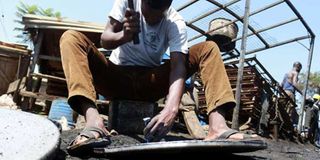Counties in trouble as virus destroys economies

A young man moulds a metallic pan at Jua Kali workshop in Kibuye Market, Kisumu. FILE PHOTO | NATION MEDIA GROUP
What you need to know:
- Kenya’s first Covid-19 positive case was reported on March 13.
- Already, counties have reviewed their spending plans in the 2020/21 financial year as a result of the pandemic, with most revising their budgets to reprioritise spending towards mitigating the negative economic impacts of Covid-19.
The Covid-19 pandemic will impact negatively on budget implementation for the counties in the last quarter of the 2019/20 financial year, which ended on Tuesday, a report by Controller of Budget Margaret Nyakang’o says.
The report, which presents the counties’ budget performance in the first nine months of the current financial year (July 2019 to March 2020), says measures put in place to contain coronavirus will slow down economic growth, which will have a ripple effect on development.
Kenya’s first Covid-19 positive case was reported on March 13.
Already, counties have reviewed their spending plans in the 2020/21 financial year as a result of the pandemic, with most revising their budgets to reprioritise spending towards mitigating the negative economic impacts of Covid-19.
“Given the disruptions occasioned by the actions taken to contain the spread of the Covid-19 disease, it is clear that the measures will negatively impact on all county governments in implementation of the FY 2019/20 budget.
“Therefore, there is need for continuous monitoring of this impact by county treasuries and departments of health. Counties should develop frameworks for action aimed at saving lives, protecting households, businesses, and the economy,” the budget implementation review report for the first nine months of 2019/20 financial year indicates.
In the document, Dr Nyakang’o warns that the pace of the disease’s disruption is likely to accelerate in the months ahead as the diseases spreads to more counties.
“Counties should develop frameworks for action aimed at saving lives, protecting households, businesses, and the economy,” she said.
The report’s findings show some counties absorbed less than 50 percent of their development budgets, meaning taxpayers were being denied services despite the availability of fund.
Development spending is critical to building infrastructure like roads and sewerage and putting money in private hands through demand for raw materials, which ultimately creates new jobs.
Nairobi, Samburu and Nyandarua had the lowest absorption of development budget at 11.1 per cent, 6 per cent, and 4.1 per cent respectively. Other counties with low absorption of development funds are Nakuru (14.3 percent), Taita Taveta(12.7 percent) and Migori (15.8 percent).
Top performers were Murang’a, Tana River, and Marsabit at 60.2 per cent, 45.6 per cent, and 43.5 per cent respectively.
In Murang’a, Sh2 billion out of their Sh3 billion allocation was used in the stocking of pharmacies, construction of roads, school feeding programmes and a number of agricultural projects.





